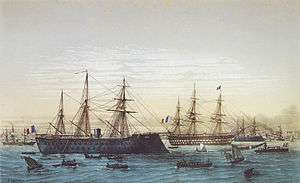French ironclad Magenta
Magenta was a broadside ironclad of the French Navy, lead ship of her class. She served as flagship of the Mediterranean Squadron.
 | |
| History | |
|---|---|
| Name: | Magenta |
| Namesake: | Battle of Magenta |
| Builder: | Brest |
| Laid down: | 22 June 1859 |
| Launched: | 22 June 1861 |
| Fate: | Exploded and sank 31 October 1875 |
| General characteristics | |
| Class and type: | Magenta-class ironclad |
| Displacement: | 7,129 tonnes |
| Propulsion: |
|
| Speed: | 12 knots (22 km/h; 14 mph) |
| Endurance: | 3 months of food, 700 tonnes of coal |
| Complement: | 681 men |
| Armament: |
|
On 21 July 1875, Magenta was serving as flagship in a naval exercise involving six ironclads – Magenta and five Alma-class central battery ironclads – and a number of smaller ships in the Tyrrhenian Sea off the east coast of Corsica . The ironclads were steaming in beautiful weather at 8 knots in two parallel columns, with Magenta leading one column, followed by Jeanne d′Arc and Reine Blanche, and Armide leading the other, followed by Thétis and Alma. At 12:00 noon the admiral commanding the squadron ordered the screw corvette Forfait, operating as a dispatch vessel, to pass astern of Magenta to receive orders. Attempting to place his ship in the column between Magenta and Jeanne d′Arc, the commanding officer of Forfait misjudged his turn, and Jeanne d′Arc collided with Forfait, her ram bow tearing into Forfait′s side. Forfait sank 14 minutes later, her crew of 160 taking safely to her boats; her commanding officer floated free from the bridge as Forfait sank beneath him, but also was rescued.[1][2]
On 31 October 1875, an accidental nighttime galley fire started aboard Magenta while she was in port at the naval base at Toulon, France, and spread out of control. Her crew was able to flood her forward gunpowder magazine but could not reach her aft magazine. When it became clear that the ship could not be saved, her crew abandoned ship, and Magenta′s aft magazine exploded shortly afterward, 2 hours 55 minutes after the fire broke out.[3] She sank in 15 meters (49 feet) of water. At the time of the accident, Magenta had a cargo of Carthaginian antiques, notably 2080 Punic stelae (Tophet, 2nd century BC) and a marble statue of Vibia Sabina (Thasos, c. 127-128 AD), found in 1874 by the Pricot de Sainte-Marie mission.
The wreck was located in April 1994. Fragments of stelae have since been recovered.[4] The statue has been partially recovered, though the head was too damaged to be rejoined to the rest of the statue. The fragments are on display at the Louvre in Paris.[5]
Notes
- Rockwell, p. 146
- dawlishchronicles.blogspot.com The ramming of the Forfait by the Jeanne d’Arc, 1875
- Chesneau, Roger, and Kolesnik, Eugene M., eds., Conway′s All the World′s Fighting Ships 1860-1905, New York: Mayflower Books, 1979, ISBN 0-8317-0302-4, p. 287.
- "Le Magenta : statue de l'impératrice Sabine". culture.gouv.fr (in French). 2001. Retrieved 20 March 2013.
- "Site officiel du musée du Louvre". cartelfr.louvre.fr (in French). 2013. Retrieved 20 March 2013.
References
- de Balincourt, Captain; Vincent-Bréchignac, Captain (1974). "The French Navy of Yesterday: Ironclad Frigates, Part I". F.P.D.S. Newsletter. Akron, OH: F.P.D.S. II (2): 18. OCLC 41554533.
- de Balincourt, Captain; Vincent-Bréchignac, Captain (1974). "The French Navy of Yesterday: Ironclad Frigates, Pt. II". F.P.D.S. Newsletter. Akron, OH: F.P.D.S. II (3): 23–25. OCLC 41554533.
- Chesneau, Roger & Kolesnik, Eugene M., eds. (1979). Conway's All the World's Fighting Ships 1860–1905. Greenwich, UK: Conway Maritime Press. ISBN 0-8317-0302-4.
- Gille, Eric (1999). Cent ans de cuirassés français [A Century of French Battleships] (in French). Nantes: Marines édition. ISBN 2-909-675-50-5.
- Jones, Colin (1996). "Entente Cordiale, 1865". In McLean, David & Preston, Antony (eds.). Warship 1996. London: Conway Maritime Press. ISBN 0-85177-685-X.
- Jumonville, P. C. & Koehler, R. B. (December 2017). "Question 37/53". Warship International. LIV (4): 282–283. ISSN 0043-0374.
- Roberts, Stephen S. (December 2018). "Question 37/53". Warship International. LV (4): 273–275. ISSN 0043-0374.
- Roche, Jean-Michel (2005). Dictionnaire des bâtiments de la flotte de guerre française de Colbert à nos jours, 1671 – 1870. Group Retozel-Maury Millau. ISBN 978-2-9525917-0-6. OCLC 165892922.
- Silverstone, Paul H. (1984). Directory of the World's Capital Ships. New York: Hippocrene Books. ISBN 0-88254-979-0.